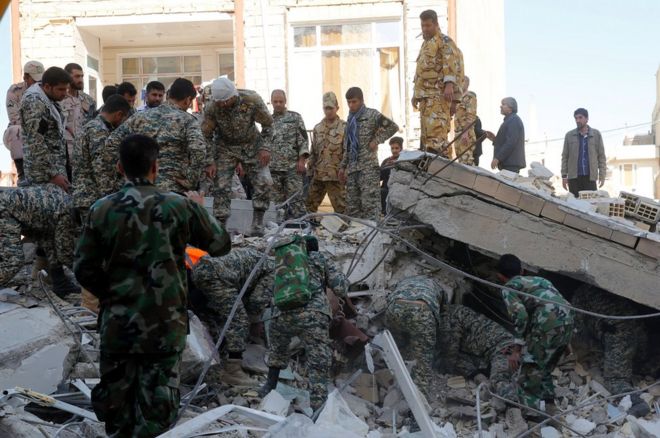 |
| Rescue teams in Iran are looking for people in collapsed buildings |
A huge rescue effort is under way after a powerful earthquake struck Iran's mountainous border with Iraq, killing more than 400 people and injuring more than 7,000.
Teams are looking for survivors trapped in the rubble of collapsed buildings.
The quake is the deadliest in the world this year.
Most people who died were in western Iran - in Sarpol-e-Zahab, a town 15km (10 miles) from the border, and other parts of Kermanshah province.
The town's main hospital was severely damaged, leaving it struggling to treat hundreds of wounded, state TV reported.
A woman and her baby were pulled alive from rubble in the town, Iranian media said.
Running water and electricity cut out in some cities, and after buildings collapsed people were forced to spend hours outdoors in parks or streets in cold weather.
Many homes in the predominantly Kurdish mountainous area are made of mud bricks and are vulnerable in quakes as large as Sunday's.
"We need shelter," a man in Sarpol-e Zahab told state TV.
"Where is the aid? Where is the help?" he asked.
One aid agency said 70,000 people needed shelter after the quake, and there were reports that thousands of people were facing a second night in the cold as dusk fell.
Iranian officials said 407 people had died in the country. Some soldiers and border guards were among the dead, the Iranian army's commander-in-chief told the state news channel IRINN.
 |
| After buildings collapsed in the earthquake, many victims spent the night outdoors |
In Iraq, nine have died, a Red Crescent spokesman told the BBC. A UN office in Iraq said more than 500 people were injured there, and the earthquake was felt in Irbil, Sulaimaniya, Kirkuk and Basra as well as the capital, Baghdad.
Landslides have made it harder for rescuers to reach those affected in rural areas, and there are fears a dam in Iraq could burst after it was damaged by the earthquake. People living nearby have reportedly been asked to leave.
The quake hit at 21:18 local time (18:18 GMT) about 30km (19 miles) south of Darbandikhan, near the north-eastern border with Iran, the US Geological Survey (USGS) said.
More than 1.8 million people live within 100km of the epicentre, the UN estimates.
The earthquake struck at a relatively shallow depth of 23.2 km, and tremors were felt in Turkey, Israel and Kuwait.

In 2003, a 6.6-magnitude quake destroyed the historic city of Bam in south-east Iran, killing 26,000 people.
Sunday's quake is the deadliest to hit Iran since 2012. But it is only the sixth earthquake of magnitude-7.0 or more in 2017 - there were 16 last year and 19 the year before.

Why is Iran prone to earthquakes?
Analysis by Jonathan Amos, BBC Science Correspondent
Iran is one of those regions of the world that is all too familiar with quakes, and has experienced some very big tremors in the past.
In general terms, the big driver here is the clash between the Arabia and Eurasia tectonic plates. The former is pushing north by a couple of centimetres a year.
In the south-east of the country, the Arabia plate is actually pushing under the Eurasia plate, but in the north-west these great slabs rub directly against each other. The Zagros mountains are a result of all this compression.
Early reports indicate the quake occurred on a thrust fault. This means the crust on one side of the break in the rocks is moved vertically up and over the other side - which fits exactly with this general picture.
Geological agencies now produce immediate bulletins on the likely expected casualties. This modelling work is based on factors such as the size of the quake, population density and what is known about local construction methods. It's inexact work, but the first bulletins suggested this event could produce many hundreds of deaths and perhaps thousands of injured individuals.
Source: BBCNews

No comments:
Post a Comment
Add a Comment...